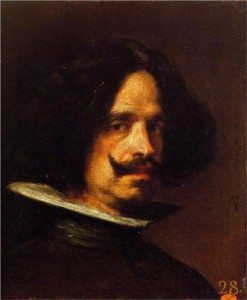Week 17: Wednesday, July 29, 2015
Diego Velázquez

PART ONE: LECTURE
Diego Velázquez, (self-portrait at right) was born
in Seville in June of 1599 and died in Madrid on August 6, 1660. His parents had been married in the same church of San Pedro within which he was now baptized on June 6. The Velázquez family came from the lower nobility and young Diego might have followed a career in law or the military. But he showed himself to be a brilliant painter from childhood and soon he was studying with one of the best painters in Seville: Francisco Pacheco. Thus Diego began a life as a painter by studying with one who had begun his own career studying El Greco in Toledo. And in the next forty years, Diego would unite in his own work lines of inspiration that would include the work of the great Venetians as El Greco knew them, as well as the brilliant High Renaissance masters Raphael and Michelangelo whom Velázquez would study in Rome, as well as mastering the work so recently created in Rome by one of the most revolutionary artists of all time: Caravaggio. Think of the styles of Titian, Tintoretto, Veronese, El Greco, Raphael, Michelangelo, and Caravaggio and that is Velázquez. His years of preparation included five years of working with Pacheco in Seville, then years in Madrid and several years of study in Italy. By mid-century, Velázquez had become one of the three greatest painters in the world: Velázquez, Rembrandt, and Vermeer. It is fascinating to study these three great painters in their three masterpieces of near mid-century and to see their shared concerns, their shared painterly inventions as well as their three totally distinct styles. The three works: Velázquez’ Las Meninas, Rembrandt’s Nightwatch, and Vermeer’s The Concert.
PART TWO: PAINTINGS
Click on Velazquez Paintings in order to see a selection of the images we see in class.